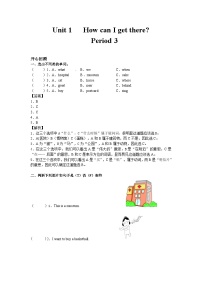

还剩2页未读,
继续阅读
所属成套资源:人教(PEP)版英语六年级上册 知识清单
成套系列资料,整套一键下载
小学英语人教版 (PEP)六年级上册Unit 1 How can I get there?综合与测试精品学案设计
展开
这是一份小学英语人教版 (PEP)六年级上册Unit 1 How can I get there?综合与测试精品学案设计,共4页。学案主要包含了核心词汇,了解词汇,核心句型,了解句型等内容,欢迎下载使用。
一、核心词汇
1. 名词: science 科学 museum 博物馆 bkstre 书店 cinema 电影院 hspital 医院 crssing 十字路口
2. 动词: turn 转弯
3. 副词: left 左 right 右 straight 笔直地
4. 短语: pst ffice 邮局
二、了解词汇
1. 名词: sir 先生 restaurant 餐馆 pizza 比萨饼 street 大街;街道 GPS 全球(卫星)定位系统 feature 特点
2. 动词: ask 问 get 到达 gave(give的过去式) 提供;交给 fllw 跟着 tell 告诉
3. 形容词: interesting 有趣的 Italian 意大利的 far 较远的
三、核心句型
1. — Where is the cinema? 电影院在哪儿?
— It’s next t the bkstre. 紧挨着书店。
2. Hw can we get there?我们怎么到那儿?
3. Turn left at the bkstre. Then turn right at the hspital.到书店左转。然后到医院右转。
注意:要注意介词的固定搭配。
Turn left/right at the … 到……左/右转。
Get ff at the … 在……下车。
It’s n the left/right.在左/右边。
Walk/G straight fr … minutes.步行/直走……分钟。
It’s east/west/suth/nrth f the … 在……东/西/南/北边。
It’s far frm the … 距离……远。
四、了解句型
1. Is there a …? ……有……吗?
拓展: there be句型
(1)主要用以表达“某处(某时)有某人(某物)”,其基本句型为“There+be 动词+名词+介词短语+其他.”
There is a ftball under the chair. 椅子下面有一个足球。
(2)there be句型有一个重要原则——就近原则。意思是be动词后的第一个物或人是单数或不可数名词, be动词就用is;是复数就用are。
There is a by, a girl and tw wmen in the huse. 房子里有一个男孩,一个女孩和两个妇女。
There are ten students and a teacher in the ffice. 办公室里有十名学生和一位教师。
(3)there be的否定形式通常是在be动词后加nt。
There isn’t a picture n the wall. 墙上没有画。
There aren’t any children in the picture. 画里一个孩子都没有。
(4)一般疑问句则把be动词提到there前, 如果句中有sme,一般要变成any。其肯定回答是“Yes, there is/are.”,否定回答是“N, there isn’t/aren’t.”。
Are there any pandas in the muntain?山上有大熊猫吗?
(5)there be 与 have的区别。
there be与 have都可表示“有”的含义。但have表示所有关系, there be表示“存在”,并且have前必须有主语。
There are sme children in the garden. 花园里有一些孩子。
She has three daughters and tw sns. 她有三个女儿和两个儿子。
2. Is the Thames far frm here?泰晤士河离这儿远吗?
一、核心词汇
1. 名词: science 科学 museum 博物馆 bkstre 书店 cinema 电影院 hspital 医院 crssing 十字路口
2. 动词: turn 转弯
3. 副词: left 左 right 右 straight 笔直地
4. 短语: pst ffice 邮局
二、了解词汇
1. 名词: sir 先生 restaurant 餐馆 pizza 比萨饼 street 大街;街道 GPS 全球(卫星)定位系统 feature 特点
2. 动词: ask 问 get 到达 gave(give的过去式) 提供;交给 fllw 跟着 tell 告诉
3. 形容词: interesting 有趣的 Italian 意大利的 far 较远的
三、核心句型
1. — Where is the cinema? 电影院在哪儿?
— It’s next t the bkstre. 紧挨着书店。
2. Hw can we get there?我们怎么到那儿?
3. Turn left at the bkstre. Then turn right at the hspital.到书店左转。然后到医院右转。
注意:要注意介词的固定搭配。
Turn left/right at the … 到……左/右转。
Get ff at the … 在……下车。
It’s n the left/right.在左/右边。
Walk/G straight fr … minutes.步行/直走……分钟。
It’s east/west/suth/nrth f the … 在……东/西/南/北边。
It’s far frm the … 距离……远。
四、了解句型
1. Is there a …? ……有……吗?
拓展: there be句型
(1)主要用以表达“某处(某时)有某人(某物)”,其基本句型为“There+be 动词+名词+介词短语+其他.”
There is a ftball under the chair. 椅子下面有一个足球。
(2)there be句型有一个重要原则——就近原则。意思是be动词后的第一个物或人是单数或不可数名词, be动词就用is;是复数就用are。
There is a by, a girl and tw wmen in the huse. 房子里有一个男孩,一个女孩和两个妇女。
There are ten students and a teacher in the ffice. 办公室里有十名学生和一位教师。
(3)there be的否定形式通常是在be动词后加nt。
There isn’t a picture n the wall. 墙上没有画。
There aren’t any children in the picture. 画里一个孩子都没有。
(4)一般疑问句则把be动词提到there前, 如果句中有sme,一般要变成any。其肯定回答是“Yes, there is/are.”,否定回答是“N, there isn’t/aren’t.”。
Are there any pandas in the muntain?山上有大熊猫吗?
(5)there be 与 have的区别。
there be与 have都可表示“有”的含义。但have表示所有关系, there be表示“存在”,并且have前必须有主语。
There are sme children in the garden. 花园里有一些孩子。
She has three daughters and tw sns. 她有三个女儿和两个儿子。
2. Is the Thames far frm here?泰晤士河离这儿远吗?














